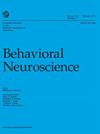成年雄性和雌性长Evans大鼠在产前适度接触酒精后,其在黑暗条件下的自发空间行为组织不受影响。
IF 1.5
4区 医学
Q3 BEHAVIORAL SCIENCES
引用次数: 0
摘要
产前接触酒精会导致多种认知功能紊乱,但对空间导航尤其有害。在开放的环境中,啮齿类动物围绕集中的地点(称为 "大本营")组织它们的空间行为,并从这些地点迂回而缓慢地运动(行进)到环境的其他部分。即使在黑暗的测试条件下,开阔地行为也是有组织的,这表明自我运动线索(前庭、运动等)在其中发挥了作用。中度产前酒精暴露(mPAE)对黑暗条件下自发开阔地行为组织的影响尚未进行过研究。在此,我们对成年雌性和雄性大鼠进行了测试,让它们在完全黑暗的测试室内的圆形空地上进行 30 分钟的 mPAE 或糖精对照暴露。在整个测试过程中,以行进距离减少和停止持续时间增加来衡量的一般运动有所减少,而以停止持续时间、原基地建立、原基地稳定性、行进准确性和峰值速度与行进长度的比例来衡量的这些行为的组织在 mPAE 和糖精对照组大鼠之间没有差异。总之,这些发现有力地表明,成年 mPAE 大鼠与自我运动线索相关的自发运动组织仍然完好无损。(PsycInfo Database Record (c) 2024 APA,保留所有权利)。本文章由计算机程序翻译,如有差异,请以英文原文为准。
Organization of spontaneous spatial behaviors under dark conditions is unaffected in adult male and female long-Evans rats after moderate prenatal alcohol exposure.
Prenatal alcohol exposure can produce disruptions in a wide range of cognitive functions, but it is especially detrimental to spatial navigation. In open environments, rodents organize their spatial behaviors around centralized locations, termed home bases, from which they make circuitous and slow locomotor trips (progressions) into the rest of the environment. Open-field behaviors are organized even under darkened test conditions, suggesting a role for self-motion cues (vestibular, motor, etc.). The impact of moderate prenatal alcohol exposure (mPAE) on the organization of spontaneous open-field behaviors under darkened conditions has not been investigated. Here we tested adult female and male rats with mPAE or saccharin control exposure in a circular open field for 30 min in a testing room that was made completely dark. While general locomotion, as measured by reductions in travel distance and increased stop duration, decreased across the test session, the organization of these behaviors, as measured by stop duration, home base establishment, home base stability, progression accuracy, and scaling of peak speeds with progression length, did not differ between mPAE and saccharin control rats. Together, the findings strongly suggest that spontaneous movement organization in relation to self-motion cues remains intact in adult mPAE rats. (PsycInfo Database Record (c) 2024 APA, all rights reserved).
求助全文
通过发布文献求助,成功后即可免费获取论文全文。
去求助
来源期刊

Behavioral neuroscience
医学-行为科学
CiteScore
3.40
自引率
0.00%
发文量
51
审稿时长
6-12 weeks
期刊介绍:
Behavioral Neuroscience publishes original research articles as well as reviews in the broad field of the neural bases of behavior.
 求助内容:
求助内容: 应助结果提醒方式:
应助结果提醒方式:


